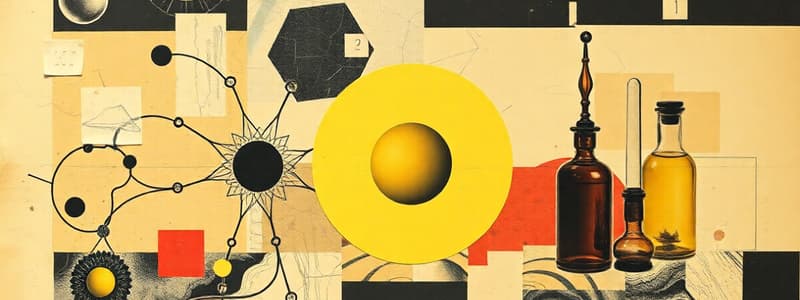Podcast
Questions and Answers
What is the primary proposition of Democritus's Theory of the Atom?
What is the primary proposition of Democritus's Theory of the Atom?
- All matter is made of tiny, indestructible particles. (correct)
- Atoms of different elements can combine freely.
- All matter has mass but no volume.
- Matter can be created and destroyed.
What law did Antoine Lavoisier introduce to the field of chemistry?
What law did Antoine Lavoisier introduce to the field of chemistry?
- Law of Conservation of Mass (correct)
- Law of Conservation of Energy
- Law of Atomic Theory
- Law of Definite Proportions
Which statement accurately reflects a point of John Dalton's Atomic Theory?
Which statement accurately reflects a point of John Dalton's Atomic Theory?
- Atoms can be created under certain conditions.
- All atoms of a given element are indistinguishable. (correct)
- The weight of all compounds is equal to their component elements.
- Atoms cannot combine to form compounds.
What model of the atom did J.J. Thomson create based on his experiments?
What model of the atom did J.J. Thomson create based on his experiments?
What was the significant discovery made by J.J. Thomson using the cathode ray tube?
What was the significant discovery made by J.J. Thomson using the cathode ray tube?
What was the primary purpose of the Gold Foil Experiment conducted by Ernest Rutherford?
What was the primary purpose of the Gold Foil Experiment conducted by Ernest Rutherford?
Which of the following best describes the Law of Definite Proportions as stated by Dalton?
Which of the following best describes the Law of Definite Proportions as stated by Dalton?
What was one of the limitations of Dalton's Atomic Theory?
What was one of the limitations of Dalton's Atomic Theory?
Flashcards
Democritus's Atomos Theory
Democritus's Atomos Theory
All matter is made up of tiny, indivisible, indestructible particles called atomos.
Solid Sphere Model
Solid Sphere Model
A model of the atom proposed by Democritus, picturing atoms as solid, indivisible spheres.
Law of Conservation of Mass (Lavoisier)
Law of Conservation of Mass (Lavoisier)
The total mass of the reactants in a chemical reaction equals the total mass of the products.
Dalton's Atomic Theory
Dalton's Atomic Theory
Signup and view all the flashcards
Dalton's Atomic Theory - Indivisible/Indestructible Atoms
Dalton's Atomic Theory - Indivisible/Indestructible Atoms
Signup and view all the flashcards
Dalton's Atomic Theory - Identical Atoms
Dalton's Atomic Theory - Identical Atoms
Signup and view all the flashcards
Dalton's Atomic Theory - Different Atoms
Dalton's Atomic Theory - Different Atoms
Signup and view all the flashcards
Dalton's Atomic Theory - Law of Conservation of Mass
Dalton's Atomic Theory - Law of Conservation of Mass
Signup and view all the flashcards
Dalton's Atomic Theory - Law of Definite Proportions
Dalton's Atomic Theory - Law of Definite Proportions
Signup and view all the flashcards
Cathode Ray Tube
Cathode Ray Tube
Signup and view all the flashcards
Electron Discovery
Electron Discovery
Signup and view all the flashcards
Plum Pudding Model
Plum Pudding Model
Signup and view all the flashcards
Gold Foil Experiment
Gold Foil Experiment
Signup and view all the flashcards
Study Notes
A Brief History of the Atom - Part 1
- Democritus proposed the "Atomos" theory, suggesting all matter is composed of indivisible particles
- He created the Solid Sphere Model of the atom (400 BC)
- Antoine Lavoisier developed the Law of Conservation of Mass, stating mass of reactants equals mass of products formed
- This is crucial for balancing chemical equations and calculating theoretical yields
- John Dalton's Atomic Theory combined existing concepts with new research
- Atoms are indivisible and indestructible (later proven false)
- Atoms of the same element are identical (later proven false due to isotopes and ions)
- Atoms of different elements are different
- Atoms combine in simple whole number ratios to form compounds
- Dalton introduced the Law of Conservation of Mass and Law of Definite Proportions.
- Law of Definite Proportions states every compound has fixed proportions of elements by mass (example is Percent Composition)
Further Atomic Model Development
- J.J. Thomson used the Cathode Ray Tube to discover the electron, which was originally called a corpuscle
- He developed the "Plum Pudding" model, depicting a sphere of positive charge with negatively charged electrons embedded within
- Ernest Rutherford's Gold Foil experiment revealed a dense, positively charged nucleus at the atom's center
- This contradicted the Plum Pudding model by showing the atom has a tiny, dense, positive core.
- Rutherford also discovered the proton
Chadwick's Contribution
- James Chadwick discovered the neutron, another subatomic particle within the nucleus.
- This discovery further refined the understanding of the atom's structure.
- Chadwick's finding was part of a follow-up to Rutherford's experiments on the nucleus.
Studying That Suits You
Use AI to generate personalized quizzes and flashcards to suit your learning preferences.




